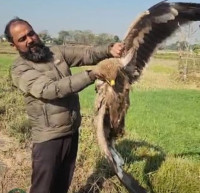National
Marching from Madhesh to Kathmandu for Chure conservation
Campaigners for controlling unchecked deforestation and haphazard extraction of sand and stones in the region.
Ramesh Kumar Paudel
On Friday, 55-year-old Shanti Devi Yadav of Janakpur was having her snacks in front of a community building at Aanptari Chowk in Narayanghat, Chitwan. Shanti Devi arrived in Narayanghat on the 19th day of walking all the way from her home for a cause. She is a member of the 22-member team that is marching from Bhardaha of Saptari district to Kathmandu to save the Chure region from illicit activities. The team is marching under the banner of Chure and Forest Conservation Campaign.
The Chure range features a string of low hills stretching from Mechi in the east to Mahakali in the west along the south of the Mahabharat hills. The range is around 20-30 km wide and 1,000 km long. Natural sources of water originating from the foothills of Chure are gradually drying up in the last few years, causing depletion of the first layer of the underground water in Bhawar (the area between Chure and the Tarai) and Tarai, experts say.
The campaigners started the long march on April 28 in a bid to exert pressure on authorities concerned about the unchecked deforestation and haphazard extraction of sand and stones in the Chure region, which has resulted in an acute water crisis in Tarai.
The campaigners, who walk around 35 to 40 kilometres daily, are on their way to Kathmandu, the national capital. They are scheduled to organise a sit-in at Maitighar, Kathmandu, to bring to light the worsening situation of Chure region.
In Shanti Devi’s house in Pulchowk, Janakpur, a hand pump has been running dry at the start of March for the past seven years. “It neither rains in the winter nor in April/May,” Shanti Devi said. “Our settlement is facing a water crisis.”
Nanda Mukhiya, aged 58, of the same settlement strongly believes they should put pressure on the government for a solution to the longstanding problem. Nanda is not well, yet he is more worried about the impending environmental crisis that the future generations will have on their hands rather than about his frail health.
“I set off on the long march with a cache of medicines in order to preserve our water sources,” Nanda said. “Wells, ponds and hand pumps started drying up in the area. Our life in Madhesh is now difficult.”
Sunil Yadav, the central coordinator of the Chure and Forest Conservation Campaign, said water sources in Tarai started drying up due to the destruction of Chure region. He claims that the government, all three levels of it, and the concerned authorities are not bothered about controlling unchecked deforestation in the Chure and Madhesh regions.
Sunil, a permanent resident of Simraungadh Municipality-2 in Bara district, had worked in a motorcycle workshop in Kalaiya until eight years ago. He used to read news and articles on the deforestation in Chure region, its impacts and possible solutions. “I realised that there will be a crisis in Madhesh unless the rampant deforestation in Chure is not controlled,” he said.
The campaign has launched the long march with a 12-point charter of demands. The campaigners ask for strong action against the forest officers who work hand in glove with smugglers, control of illegal extraction of river-bed materials from the rivers and streams in the Chure region, declaration of Madhesh as a dry zone, and concrete plans to control forest fires. They also demand that Dilip Mahato, an environmental activist who was killed for raising his voice against illegal extraction of sand and pebble, be declared the country’s first conservation martyr.
Twenty-four-year-old Mahato, who had been protesting against illegal mining of Aurahi riverbed material, was dragged and killed by a tipper truck in the wee hours on 10 January, 2020.
The campaign had organised a similar long march to Kathmandu last year demanding control of the pollution of the Sirsiya river that flows through Birgunj, a major business and industrial hub in Parsa district of Madhesh Province. The campaigners met high level government officers and ministers in Kathmandu. “The then home minister and industry minister had assured us they’d take initiatives for the control of water pollution in the river,” Sunil said. “But nothing has happened yet.”
The Sirsiya river has become highly polluted due to the toxic industrial waste generated by several factories on the Parsa-Bara Industrial Corridor. The factories release untreated waste into the river, locals say, resulting in the waterway turning into an open sewer.
In its 12-point demand, the campaign has included the issue of Sirsiya River this time as well.
“The government does not have a suitable policy on the posting and transfer of forest officials. Some officers stay in the same area for years under political protection. They support smugglers instead of taking strong action against them,” said Sunil, urging all to join hands for the conservation of the Chure region.
Of the 22 members in the long march, 13 are women.
The long march will conclude after reaching Maitighar, Kathmandu, in a few days. The campaigners said they will launch an hour-long sit-in every day in front of the party office of major political parties and submit the 12-point memorandum.
“This march is not for an individual,” Shanti Devi said, as she continued having her snack. “Despite hardships, I decided to participate to protect our society and the whole nation from an impending environmental crisis.”




 18.12°C Kathmandu
18.12°C Kathmandu1.jpg)















